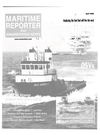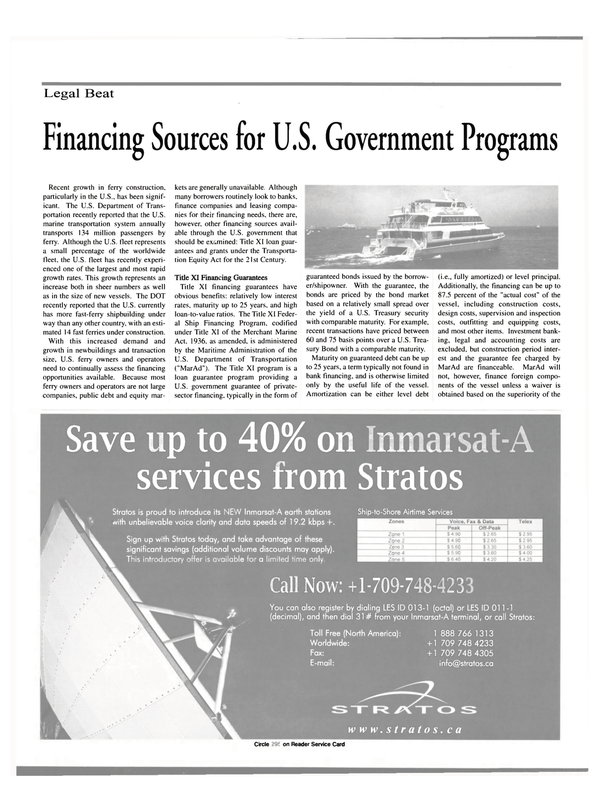
Financing Sources for U.S. Government Programs
Recent growth in ferry construction, particularly in the U.S., has been significant.
The U.S. Department of Transportation recently reported that the U.S.
marine transportation system annually transports 134 million passengers by ferry. Although the U.S. fleet represents a small percentage of the worldwide fleet, the U.S. fleet has recently experienced one of the largest and most rapid growth rates. This growth represents an increase both in sheer numbers as well as in the size of new vessels. The DOT recently reported that the U.S. currently has more fast-ferry shipbuilding under way than any other country, with an estimated 14 fast ferries under construction.
With this increased demand and growth in newbuildings and transaction size, U.S. ferry owners and operators need to continually assess the financing opportunities available. Because most ferry owners and operators are not large companies, public debt and equity markets are generally unavailable. Although many borrowers routinely look to banks, finance companies and leasing companies for their financing needs, there are, however, other financing sources available through the U.S. government that should be examined: Title XI loan guarantees and grants under the Transportation Equity Act for the 21st Century.
Title XI Financing Guarantees Title XI financing guarantees have obvious benefits: relatively low interest rates, maturity up to 25 years, and high loan-to-value ratios. The Title XI Federal Ship Financing Program, codified under Title XI of the Merchant Marine Act, 1936. as amended, is administered by the Maritime Administration of the U.S. Department of Transportation ("MarAd"). The Title XI program is a loan guarantee program providing a U.S. government guarantee of privatesector financing, typically in the form of guaranteed bonds issued by the borrower/ shipowner. With the guarantee, the bonds are priced by the bond market based on a relatively small spread over the yield of a U.S. Treasury security with comparable maturity. For example, recent transactions have priced between 60 and 75 basis points over a U.S. Treasury Bond with a comparable maturity.
Maturity on guaranteed debt can be up to 25 years, a term typically not found in bank financing, and is otherwise limited only by the useful life of the vessel.
Amortization can be either level debt (i.e., fully amortized) or level principal.
Additionally, the financing can be up to 87.5 percent of the "actual cost" of the vessel, including construction costs, design costs, supervision and inspection costs, outfitting and equipping costs, and most other items. Investment banking, legal and accounting costs are excluded, but construction period interest and the guarantee fee charged by MarAd are financeable. MarAd will not, however, finance foreign components of the vessel unless a waiver is obtained based on the superiority of the foreign equipment considering price, delivery time or quality (foreign equipment not financed may be used as equity) The costs of the guarantee consist of (i) a small $5,000 application fee, (ii) an investigation fee is equal to 5 percent of guarantee amount up to $10,000,000, plus 1.25 percent of guarantee amount in excess of $10,000,000, and (iii) a guarantee fee. The guarantee fee, paid upon issuance of the debt, is financeable and is based on the present value of an annual fee equal to 2.5 percent through 5 percent of guarantee amount during construction and 5 percent through one percent after delivery. Lower fees are charged to borrowers with lower debtto- equity ratios. Of course, there are other costs, such as investment banking, legal and accounting that vary based on each transaction. Investment banking fees are generally 0.375 percent to 0.5 percent of the principal amount of bonds sold and legal fees typically range from $50,000 to well over $100,000 for complex transactions.
To be eligible for Title XI financing, a vessel must be constructed, reconstructed or reconditioned in U.S. shipyards, but can be used in either the domestic or foreign trade. Each proposed project undergoes a thorough due diligence review by MarAd, including an economic feasibility study, financial tests, a review of operating experience, and collateral review. MarAd will also need to be comfortable with the ability of the shipyard and its financial strength.
The process for obtaining Title XI financing can take from six weeks to several years depending on various factors, including complexity of the transaction.
A typical transaction takes six to nine months. Pre-application meetings and regular contact with MarAd are essential to timely completion of the transaction. After submission of the initial application, MarAd will request additional information and, once all information is obtained, will either reject or accept the transaction within 60 days. If the transaction is accepted, a commitment letter will be issued and documentation will be completed.
T E A - 2 1 G r a n ts The Transportation Equity Act for the 21st Century ("TEA-21") created two primary financing sources for ferries: The Ferry Boat Discretionary Program ("FBDP"), which is a discretionary grant program established solely for ferry boats and terminals, and the Congestion Mitigation and Air Quality Improvement Program ("CMAQ"), which is not limited to ferries and, in fact, only recently has been used to finance ferry projects. Changes in TEA- 21 opened up both the FBDP and CMAQ to private owners and operators, recognizing the important role that the private sector plays in meeting transportation infrastructure needs.
Ferry Boat Discretionary Program Originally established by the Intermodal Surface Transportation Equity Act "ISTEA" in 1991, and administered by the DOT's Federal Highway Administration (FHWA), the FBDP encourages public and private operators to address marine transportation infrastructure needs. FBDP funds are available for construction or improvement of ferry boats and ferry terminal facilities.
FBDP funding has been set at $38 million per year for each of fiscal years 1999-2003. Of those totals, $20 million per year was earmarked for Alaska ($ 10 million), New Jersey ($5 million) and Washington ($5 million). The remaining $18 million per year is available for open competition, subject to certain overall budgetary constraints. The maximum amount of a project that can be funded by the FBDP is 80 percent, with the remaining 20 percent funded from other sources, which can be a combination of state, local or private sources.
To be eligible for FBDP funding, the ferry and/or terminal to be constructed or improved must be (a) publicly owned, or (b) publicly operated, or (c) majority owned by a public authority if the operation provides substantial public benefits.
In addition, the ferry must have a route linked to a public road (other than an Interstate highway) or provide passenger- only service. Ferries that operate in international waters, except for Hawaii. Puerto Rico, Alaska, and ferries between the United States and Canada, are ineligible.
Companies interested in receiving FBDP funding must submit an application to their state department of transportation, which then forwards selected applications to the FHWA. The FHWA then selects projects based on the following criteria: (1) expeditious completion; (2) leverage of private or other public funding; (3) amount of funding requested (smaller requests are given priority); (4) state priorities; and (5) national geographic distribution of funding.
Congestion Mitigation Air Quality Improvement Program The CMAQ program, also initially established under ISTEA, funds transportation projects that will reduce traffic congestion and improve air quality.
Administered by the FHWA and the Federal Transit Administration ("FTA"), the CMAQ program provides funding for capital improvements, as well as operating assistance. The federal share for most projects funded under CMAQ is 80-90 percent. Total CMAQ program funding of has been authorized at approximately $1.4 billion for each of fiscal years 1999-2003.
CMAQ funds are apportioned to states based on a statutory formula, incorporating the air quality and population of the state. The method of allocation of CMAQ funds to projects varies within each state with either the state department of transportation, the relevant metropolitan planning organization, or both generally having responsibility for CMAQ funds. CMAQ money is available only in areas that have not been in compliance with air quality standards under the federal Clean Air Act for certain air pollutants. Generally, medium to large metropolitan areas are eligible.
Projects must result in tangible emissions reductions. Projects also must be included in a state's conforming transportation plan and in its transportation improvement program, which are required by TEA-21.
Conclusion There are a number of financing sources for ferries in today's market.
Which option, or combination of options, is best depends on the situation of the operator, whether a start-up or existing business. An operator should explore all alternatives and select one to maximize benefits. Generally, only larger borrowers will find it easy to access bank lending, while finance companies provide more flexibility. Title XI is always a good option if you have the required equity and can pass the government's due diligence standards. Where operators can team up with a public sponsor and where a project meets a demonstrated transportation need, federal grants under TEA-21 provide an attractive option.
Read Financing Sources for U.S. Government Programs in Pdf, Flash or Html5 edition of April 2000 Maritime Reporter
Other stories from April 2000 issue
Content
- Corsaire 13000 Embodies Integrated, Advanced Propulsion System page: 48D
- Jotun: Greening the trade in crude page: 8
- Financing Sources for U.S. Government Programs page: 14
- Deltamarin And Almaco Join Together page: 18
- ASRY Reports Prosperous 1999 page: 18
- A New View page: 20
- The Smokeless Solution Is Coming Over The Horizon page: 22
- Strategic Value Adding Purchasing page: 28
- DCR Optimistic About Future Of Offshore Drilling Sector page: 34
- Offshore Industry Leaders Invest Heavily In Safety Programs page: 36
- Electronic Engines Power New OSV Breed page: 40
- Angola And Canada Provide Projects For Smit Pioneer page: 40
- Rig Repowered At Houston Ship Repair page: 41
- Charting The World Electronically page: 44
- Reality Checked page: 45
- NoFire Technologies Helps Ships Meet SOLAS page: 48
- Is Diesel-Electric Propulsion the System for You? page: 50
- Drew Marine, MAN B&W Launch Redesigned Fuel Mill page: 52
- Austal Breaks 24-Hour Record page: 53
- PropExpert V. 4.2 Released page: 53
- GE To Supply Gas Turbines For IHI page: 54
- Jabsco Offers Oil Change Kit page: 54
- Calling All Mariners page: 56
- MTN, BT Hook-Up Cruise Ships To Cell Phone Network page: 59
- Norwegian Manufacturers Maintain Edge page: 60
- Leica Extends Its Influence In DGPS Arena page: 69
- ViaSat Ups Phase Two page: 69
- Encouraging best practice onboard using video and interactive media page: 73
- Blount Completes Dinner Vessel page: 74
- ACCL Offers New Chicago-Based Cruises page: 78
- Boatracs To Exclusively Distribute MarStar page: 78
- DNV Cleans Up With Celebrity's Millennium page: 79
- Transas Unveils GMDSS Simulator page: 85


